
Military history of Greece during World War II
Encyclopedia
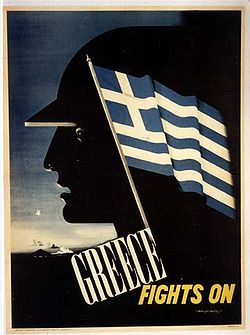
Greece
Greece , officially the Hellenic Republic , and historically Hellas or the Republic of Greece in English, is a country in southeastern Europe....
entered World War II
World War II
World War II, or the Second World War , was a global conflict lasting from 1939 to 1945, involving most of the world's nations—including all of the great powers—eventually forming two opposing military alliances: the Allies and the Axis...
on 28 October 1940, when the Italian army invaded from Albania
Albania
Albania , officially known as the Republic of Albania , is a country in Southeastern Europe, in the Balkans region. It is bordered by Montenegro to the northwest, Kosovo to the northeast, the Republic of Macedonia to the east and Greece to the south and southeast. It has a coast on the Adriatic Sea...
, beginning the Greco-Italian War
Greco-Italian War
The Greco-Italian War was a conflict between Italy and Greece which lasted from 28 October 1940 to 23 April 1941. It marked the beginning of the Balkans Campaign of World War II...
. The Greek army was able to stop the invasion and even push back the Italians into Albania
Albania
Albania , officially known as the Republic of Albania , is a country in Southeastern Europe, in the Balkans region. It is bordered by Montenegro to the northwest, Kosovo to the northeast, the Republic of Macedonia to the east and Greece to the south and southeast. It has a coast on the Adriatic Sea...
, thereby winning one of the first victories for the Allies
Allies of World War II
The Allies of World War II were the countries that opposed the Axis powers during the Second World War . Former Axis states contributing to the Allied victory are not considered Allied states...
. The Greek successes and the inability of the Italians to reverse the situation forced Nazi Germany
Nazi Germany
Nazi Germany , also known as the Third Reich , but officially called German Reich from 1933 to 1943 and Greater German Reich from 26 June 1943 onward, is the name commonly used to refer to the state of Germany from 1933 to 1945, when it was a totalitarian dictatorship ruled by...
to intervene in order to protect her main Axis
Axis Powers
The Axis powers , also known as the Axis alliance, Axis nations, Axis countries, or just the Axis, was an alignment of great powers during the mid-20th century that fought World War II against the Allies. It began in 1936 with treaties of friendship between Germany and Italy and between Germany and...
partner's prestige. The Germans invaded
Battle of Greece
The Battle of Greece is the common name for the invasion and conquest of Greece by Nazi Germany in April 1941. Greece was supported by British Commonwealth forces, while the Germans' Axis allies Italy and Bulgaria played secondary roles...
Greece and Yugoslavia
Invasion of Yugoslavia
The Invasion of Yugoslavia , also known as the April War , was the Axis Powers' attack on the Kingdom of Yugoslavia which began on 6 April 1941 during World War II...
on 6 April 1941, and overran both countries within a month, despite British aid to Greece in the form of an expeditionary corps. The conquest of Greece was completed in May with the capture
Battle of Crete
The Battle of Crete was a battle during World War II on the Greek island of Crete. It began on the morning of 20 May 1941, when Nazi Germany launched an airborne invasion of Crete under the code-name Unternehmen Merkur...
of Crete
Crete
Crete is the largest and most populous of the Greek islands, the fifth largest island in the Mediterranean Sea, and one of the thirteen administrative regions of Greece. It forms a significant part of the economy and cultural heritage of Greece while retaining its own local cultural traits...
from the air, although the Fallschirmjäger
Fallschirmjäger
are German paratroopers. Together with the Gebirgsjäger they are perceived as the elite infantry units of the German Army....
suffered such extensive casualties in this operation that the Germans abandoned large-scale airborne operations for the remainder of the war. The German diversion of resources in the Balkans is also considered by some historians to have delayed the launch of the invasion
Operation Barbarossa
Operation Barbarossa was the code name for Germany's invasion of the Soviet Union during World War II that began on 22 June 1941. Over 4.5 million troops of the Axis powers invaded the USSR along a front., the largest invasion in the history of warfare...
of the Soviet Union
Soviet Union
The Soviet Union , officially the Union of Soviet Socialist Republics , was a constitutionally socialist state that existed in Eurasia between 1922 and 1991....
by a critical month, which proved disastrous when the German army failed to take Moscow.
Greece itself was occupied and divided between Germany, Italy and Bulgaria, while the King and the government fled into exile
Greek government in exile
The Greek government in exile was the official government of Greece, headed by King George II, which evacuated from Athens in April 1941, after the German invasion of the country, first to the island of Crete and then to Cairo in Egypt. Hence it is also referred to as the "Cairo Government"...
in Egypt. First attempts at armed resistance in summer 1941 were crushed by the Axis, but the Resistance movement
Greek Resistance
The Greek Resistance is the blanket term for a number of armed and unarmed groups from across the political spectrum that resisted the Axis Occupation of Greece in the period 1941–1944, during World War II.-Origins:...
began again in 1942 and grew enormously in 1943 and 1944, liberating large parts of the country's mountainous interior and tying down considerable Axis forces. However, political tensions between the Resistance groups resulted in the outbreak of a civil conflict among them in late 1943, which continued until the spring of 1944. The exiled Greek government also formed armed forces of its own, which served and fought alongside the British in the Middle East, North Africa and Italy. The contribution of the Greek war and the merchant navies in particular was of special importance to the Allied cause.
Mainland Greece was liberated in October 1944 with the German withdrawal in the face of the advancing Red Army
Red Army
The Workers' and Peasants' Red Army started out as the Soviet Union's revolutionary communist combat groups during the Russian Civil War of 1918-1922. It grew into the national army of the Soviet Union. By the 1930s the Red Army was among the largest armies in history.The "Red Army" name refers to...
, while German garrisons continued to hold out in the Aegean Islands
Aegean Islands
The Aegean Islands are the group of islands in the Aegean Sea, with mainland Greece to the west and north and Turkey to the east; the island of Crete delimits the sea to the south, those of Rhodes, Karpathos and Kasos to the southeast...
until after the war's end. The country was devastated by war and occupation, and its economy and infrastructure lay in ruins. Greece suffered more than 400,000 casualties during the occupation, and the country's Jewish community was almost completely exterminated in the Holocaust. By 1946, however, a vicious civil war
Greek Civil War
The Greek Civil War was fought from 1946 to 1949 between the Greek governmental army, backed by the United Kingdom and United States, and the Democratic Army of Greece , the military branch of the Greek Communist Party , backed by Bulgaria, Yugoslavia and Albania...
erupted between the British and American-sponsored conservative government and leftist guerrillas, which would last until 1949.
Fascist Italy invades Greece
The Italian invasion from AlbaniaAlbania
Albania , officially known as the Republic of Albania , is a country in Southeastern Europe, in the Balkans region. It is bordered by Montenegro to the northwest, Kosovo to the northeast, the Republic of Macedonia to the east and Greece to the south and southeast. It has a coast on the Adriatic Sea...
on October 28, 1940, after making small initial gains, was stopped by the determined defense of Greek forces in the battles at the Elaia-Kalamas line and the Pindus
Battle of Pindus
The Battle of Pindus took place in the Pindus Mountains in Epirus and West Macedonia, Greece, in the autumn of 1940, between October 28 – November 13. The battle was fought between the Greek and the Italian armies during the first stages of the Greco-Italian War...
Mountains. The unwillingness of Bulgaria
Bulgaria
Bulgaria , officially the Republic of Bulgaria , is a parliamentary democracy within a unitary constitutional republic in Southeast Europe. The country borders Romania to the north, Serbia and Macedonia to the west, Greece and Turkey to the south, as well as the Black Sea to the east...
to attack Greece, as the Italians had hoped, allowed the Greek High Command to transfer most of the mobilizing divisions intended for the garrisoning of Macedonia
Macedonia (region)
Macedonia is a geographical and historical region of the Balkan peninsula in southeastern Europe. Its boundaries have changed considerably over time, but nowadays the region is considered to include parts of five Balkan countries: Greece, the Republic of Macedonia, Bulgaria, Albania, Serbia, as...
to the front, where they were instrumental in the Greek counteroffensive, launched on November 14. Greek forces crossed the border into Albania and took city after city despite facing a harsh winter, having inadequate supplies and facing Italian air superiority. By mid-January, Greek forces had occupied a quarter of Albania, but the offensive had come to a standstill before it had reached its objective, the port of Vlorë
Vlorë
Vlorë is one of the biggest towns and the second largest port city of Albania, after Durrës, with a population of about 94,000 . It is the city where the Albanian Declaration of Independence was proclaimed on November 28, 1912...
.
This situation prompted Germany to come to the rescue of its junior Axis partner. In a final attempt to restore Italian prestige before the German intervention, a counterattack was launched on March 9, 1941 against the key sector of Klissura, under Mussolini's personal supervision. Despite massive artillery bombardments and the employment of several divisions on a narrow front, the attack failed to make any headway and was called off after almost two weeks.
The German invasion
The long-anticipated German attack (Unternehmen Marita) began on April 6 1941, against both Greece and YugoslaviaKingdom of Yugoslavia
The Kingdom of Yugoslavia was a state stretching from the Western Balkans to Central Europe which existed during the often-tumultuous interwar era of 1918–1941...
. The resulting "Battle of Greece" ended with the fall of Kalamata
Kalamata
Kalamata is the second-largest city of the Peloponnese in southern Greece. The capital and chief port of the Messenia prefecture, it lies along the Nedon River at the head of the Messenian Gulf...
in the Peloponnese
Peloponnese
The Peloponnese, Peloponnesos or Peloponnesus , is a large peninsula , located in a region of southern Greece, forming the part of the country south of the Gulf of Corinth...
on April 30, the evacuation of the Commonwealth Expeditionary Force and the complete occupation of the Greek mainland by the Axis.
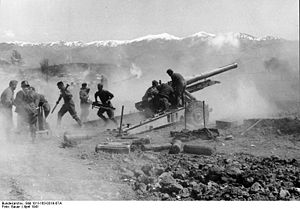
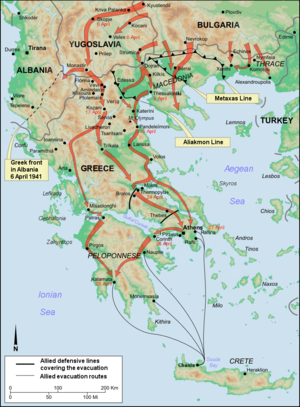
Metaxas Line
The Metaxas Line was a chain of fortifications constructed along the line of the Greco-Bulgarian border, designed to protect Greece in case of a Bulgarian invasion after the rearmament of Bulgaria. It was named after Ioannis Metaxas, the then Prime Minister of Greece, and chiefly consists of...
" (19 forts in Eastern Macedonia between Mt. Beles and River Nestos and 2 more in Western Thrace). It was launched from Bulgarian territory and supported by artillery and bomber aircraft. The resistance of the forts was both courageous and determined, but eventually futile. The rapid collapse of Yugoslavia had allowed
the 2nd Panzer Division (which had started from the Strumica Valley in Bulgaria, advanced through Yugoslav territory and turned south along the Vardar/Axios River valley) to bypass the defenses and capture the vital port city of Thessaloniki
Thessaloniki
Thessaloniki , historically also known as Thessalonica, Salonika or Salonica, is the second-largest city in Greece and the capital of the region of Central Macedonia as well as the capital of the Decentralized Administration of Macedonia and Thrace...
on April 9. As a result, the Greek forces manning the forts (the Army Section of Eastern Macedonia, TSAM) were cut off and given permission to surrender by the Greek High Command. The surrender was completed the next day, April 10, the same day that German forces crossed the Yugoslav-Greek border near Florina
Florina
Florina is a town and municipality in mountainous northwestern Macedonia, Greece. Its motto is, 'Where Greece begins'. It is also the Metropolitan seat for the region. It lies in the central part of Florina peripheral unit, of which it is the capital. Florina belongs to the periphery of West...
in Western Macedonia, after having defeated any resistance in southern Yugoslavia. The Germans broke through the Commonwealth (2 div. & 1 arm. brig.) and Greek (2 div.) defensive positions in the Kleidi area on April 11/12, and moved on to the south and southwest.
While pursuing the British southwards, the southwest movement threatened the rear of the bulk of the Greek Army (14 divisions), which was facing the Italians at the Albanian front. The Army belatedly began retreating southwards, first its northeast flank on April 12, and finally the southwest flank on April 17. The German thrust towards Kastoria on April 15 however made the situation critical, threatening to cut the Greek forces' retreat. The generals at the front began exploring the possibilities for capitulation (to the Germans only), despite the High Command's insistence on continuing the fight to cover the British retreat.
In the event, several generals under the leadership of Lt.Gen. Georgios Tsolakoglou
Georgios Tsolakoglou
Georgios Tsolakoglou was a Greek military officer who became the first Prime Minister of the Greek collaborationist government during the Axis Occupation in 1941-1942.-Military career:...
mutinied on April 20, and taking matters in their own hands, signed a protocol of surrender with the commander of the "Leibstandarte SS Adolf Hitler" near Metsovo
Metsovo
Metsovo is a town in Epirus on the mountains of Pindus in northern Greece, between Ioannina to the north and Meteora to the south. The largest centre of Vlach life in Greece, Metsovo is bypassed by GR-6 and also by Egnatia Odos Motorway....
the same day. It was followed by a second in Ioannina
Ioannina
Ioannina , often called Jannena within Greece, is the largest city of Epirus, north-western Greece, with a population of 70,203 . It lies at an elevation of approximately 500 meters above sea level, on the western shore of lake Pamvotis . It is located within the Ioannina municipality, and is the...
the next day (with Italian representation this time) and a final one in Thessaloniki between the three combatants on the 23rd. The very same day in Athens, Lt. General A. Papagos resigned his office as Supreme Commander whereas the King
George II of Greece
George II reigned as King of Greece from 1922 to 1924 and from 1935 to 1947.-Early life, first period of kingship and exile:George was born at the royal villa at Tatoi, near Athens, the eldest son of King Constantine I of Greece and his wife, Princess Sophia of Prussia...
and his government embarked for Crete
Crete
Crete is the largest and most populous of the Greek islands, the fifth largest island in the Mediterranean Sea, and one of the thirteen administrative regions of Greece. It forms a significant part of the economy and cultural heritage of Greece while retaining its own local cultural traits...
. About the same time the Commonwealth forces made a last stand at Thermopylae
Thermopylae
Thermopylae is a location in Greece where a narrow coastal passage existed in antiquity. It derives its name from its hot sulphur springs. "Hot gates" is also "the place of hot springs and cavernous entrances to Hades"....
before their final retreat to the ports of Peloponnese for evacuation to Crete or Egypt. German troops seized the Corinth Canal
Corinth Canal
The Corinth Canal is a canal that connects the Gulf of Corinth with the Saronic Gulf in the Aegean Sea. It cuts through the narrow Isthmus of Corinth and separates the Peloponnesian peninsula from the Greek mainland, thus effectively making the former an island. The builders dug the canal through...
bridges, entered Athens on April 27, and completed their occupation of the mainland and most islands by the end of the month.
The Battle of Crete
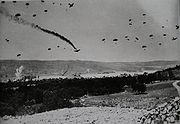
Crete
Crete is the largest and most populous of the Greek islands, the fifth largest island in the Mediterranean Sea, and one of the thirteen administrative regions of Greece. It forms a significant part of the economy and cultural heritage of Greece while retaining its own local cultural traits...
, which was held by a strong Allied garrison. To conquer it, the German High Command prepared "Unternehmen Merkur", the largest airborne attack seen to date.
The attack was launched on May 20, 1941. The Germans attacked the three main airfields of the island, at the northern towns of Maleme
Maleme
Maleme is a town and airport to the west of Chania, in North Western Crete, Greece. It is located in Platanias municipality, in Chania prefecture....
, Rethimnon, and Heraklion
Heraklion
Heraklion, or Heraclion is the largest city and the administrative capital of the island of Crete, Greece. It is the 4th largest city in Greece....
, with paratroopers and gliders. The Germans met stubborn resistance from the British, Australian, New Zealand and the remaining Greek troops on the island, and from local civilians. At the end of the first day, none of the objectives had been reached and the Germans had suffered around 4,000 casualties.
During the next day however, through miscommunication and failure of the Allied commanders to grasp the situation, Maleme airfield in western Crete fell to the Germans. With Maleme airfield secured, the Germans flew in thousands of reinforcements and overwhelmed the western side of the island. This was followed by severe British naval loses due to intense German air attacks around the island. After seven days of fighting the Allied commanders realized that so many Germans had been flown in that hope of Allied victory was gone. By June 1, the evacuation of Crete by the Allies was complete and the island was under German occupation. In light of the heavy casualties suffered by the elite 7th Flieger Division, Adolf Hitler forbade further airborne operations. General Kurt Student
Kurt Student
Kurt Student was a German Luftwaffe general who fought as a fighter pilot during the First World War and as the commander of German Fallschirmjäger during the Second World War.-Biography:...
would dub Crete "the graveyard of the German paratroopers" and a "disastrous victory."
Occupation forces
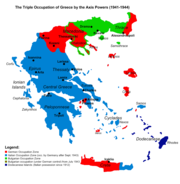
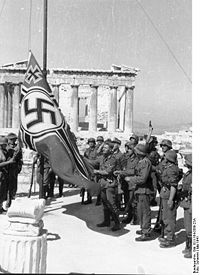
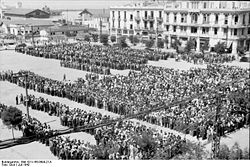
Germany
Germany , officially the Federal Republic of Germany , is a federal parliamentary republic in Europe. The country consists of 16 states while the capital and largest city is Berlin. Germany covers an area of 357,021 km2 and has a largely temperate seasonal climate...
, Italy
Italy
Italy , officially the Italian Republic languages]] under the European Charter for Regional or Minority Languages. In each of these, Italy's official name is as follows:;;;;;;;;), is a unitary parliamentary republic in South-Central Europe. To the north it borders France, Switzerland, Austria and...
and Bulgaria
Bulgaria
Bulgaria , officially the Republic of Bulgaria , is a parliamentary democracy within a unitary constitutional republic in Southeast Europe. The country borders Romania to the north, Serbia and Macedonia to the west, Greece and Turkey to the south, as well as the Black Sea to the east...
. The Germans controlled Athens, Central Macedonia, Western Crete, Milos, Amorgos and the islands of the Northern Aegean. Bulgaria annexed Thrace
Thrace
Thrace is a historical and geographic area in southeast Europe. As a geographical concept, Thrace designates a region bounded by the Balkan Mountains on the north, Rhodope Mountains and the Aegean Sea on the south, and by the Black Sea and the Sea of Marmara on the east...
and Eastern Macedonia
Macedonia (region)
Macedonia is a geographical and historical region of the Balkan peninsula in southeastern Europe. Its boundaries have changed considerably over time, but nowadays the region is considered to include parts of five Balkan countries: Greece, the Republic of Macedonia, Bulgaria, Albania, Serbia, as...
, while Italy
Italy
Italy , officially the Italian Republic languages]] under the European Charter for Regional or Minority Languages. In each of these, Italy's official name is as follows:;;;;;;;;), is a unitary parliamentary republic in South-Central Europe. To the north it borders France, Switzerland, Austria and...
occupied the rest of the country. The Italians were thus responsible for the greater part of Greece, especially the countryside, where any armed Resistance might take place. Italian forces in Greece comprised 11 infantry divisions, grouped in the 11th Army under General Carlo Geloso
Carlo Geloso
Carlo Geloso , was an Italian military officer who rose to the rank of General, commanding the Italian occupation army in Greece during the Second World War....
, with a further division in the Italian colony of the Dodecanese Islands. The Italians adopted a rather relaxed attitude towards their security duties, but they were in part justified to do so. Until the summer of 1942, as the Resistance movement was in its infancy, they faced little real opposition and considered the situation to have been normalized. The Germans limited themselves during the first period of the Occupation to the strategically important areas, and their forces were limited. The German troops in southeastern Europe came under the 12th Army
German Twelfth Army
- History :The 12th Army was activated on October 13, 1939 with General Wilhelm List in command. First seeing defensive action along the Siegfried Line, the army was involved in the invasion and occupation of France...
headed initially by Field Marshal Wilhelm List and later by General Alexander Löhr
Alexander Löhr
Alexander Löhr was an Austrian Air Force commander during the 1930s and, after the "Political Union of Germany and Austria" , he was a German Air Force commander...
. In Greece, two separate commands were created: the Salonica-Aegean Military Command at Thessalonica and the Southern Greece Military Command at Athens, for the entire duration of the war under Luftwaffe General Helmuth Felmy. Crete was organized as a fortress ("Festung Kreta
Fortress Crete
Fortress Crete was the term used during World War II by the German occupation forces to refer to the garrison and fortification of the Greek island of Crete, which they had captured after a fierce battle at the end of May 1941...
") garrisoned by the Fortress Division "Kreta", and after August garrisoned by the crack 22nd Air Landing Division. The Bulgarians occupied their own zone with an Army Corps, and, faced with active resistance from the local population, engaged from the outset in a policy of Bulgarization of the area.
After mid-1942, with the growth of armed Resistance, and the spectacular destruction of the Gorgopotamos bridge (Operation "Harling"
Operation Harling
Operation Harling was a World War II mission by the British Special Operations Executive , in cooperation with the Greek Resistance groups ELAS and EDES, which destroyed the heavily guarded Gorgopotamos viaduct in Central Greece on 25 November 1942...
) by a force of Greek guerrillas and British saboteurs on 25 November, the Italian authorities tried vainly to contain the surge in acts of resistance directed against their forces. The guerrillas were largely successful against the Italians, allowing for the creation of "liberated" areas in the mountainous interior, including sizeable towns, by mid-1943. At that time, however, German troops began being moved into Greece. Elite formations such as the 1st Panzer Division and the 1st Mountain Division were brought into the country, both in anticipation of a possible Allied landing in Greece (a concept deliberately promoted by the Allies themselves as a diversion from the landings at Sicily
Allied invasion of Sicily
The Allied invasion of Sicily, codenamed Operation Husky, was a major World War II campaign, in which the Allies took Sicily from the Axis . It was a large scale amphibious and airborne operation, followed by six weeks of land combat. It launched the Italian Campaign.Husky began on the night of...
) and as a guarantee against a possible Italian capitulation.
These forces, especially the experienced mountain troops, engaged in large-scale counter-guerrilla operations in the area of Epirus
Epirus (region)
Epirus is a geographical and historical region in southeastern Europe, shared between Greece and Albania. It lies between the Pindus Mountains and the Ionian Sea, stretching from the Bay of Vlorë in the north to the Ambracian Gulf in the south...
. Their operations were successful in that they reduced the threat of guerrilla attacks on the occupation forces, but their often brutal conduct and mass reprisal
Reprisal
In international law, a reprisal is a limited and deliberate violation of international law to punish another sovereign state that has already broken them. Reprisals in the laws of war are extremely limited, as they commonly breached the rights of civilians, an action outlawed by the Geneva...
s policy resulted in massacres of civilians such as that of Kommeno
Kommeno
Kommeno is a village and a former community in the Arta peripheral unit, Epirus, Greece. Since the 2011 local government reform it is part of the municipality Nikolaos Skoufas, of which it is a municipal unit. Population 835 . During the Axis Occupation of Greece in World War II, the village was...
on August 16, the Massacre of Distomo, or the "Massacre of Kalavryta
Massacre of Kalavryta
The Holocaust of Kalavryta , or the Massacre of Kalavryta , refers to the extermination of the male population and the subsequent total destruction of the town of Kalavryta, in Greece, by German occupying forces during World War II on 13 December 1943...
" in December. In anticipation of the Italian collapse, the German command structure throughout the Balkans was reorganized: Army Group E
Army Group E
Army Group E was a German Army Group active during World War II.Army Group E was created on 1 January 1943 from the 12th Army...
under Löhr took over in Greece, overseeing both German forces and the Italian 11th Army.
The Italian capitulation in September caused most Italian units to surrender to the Germans, although others, such as the Pinerolo division and the Aosta Cavalry Regiment, went over to the guerrillas, or chose to resist the German takeover. This resulted in brief but violent clashes between Germans and Italians, accompanied by atrocities against Italian prisoners of war, such as the massacre of the Acqui Division on Cephallonia, dramatized by the film Captain Corelli's Mandolin
Captain Corelli's Mandolin
Captain Corelli's Mandolin, released simultaneously as Corelli's Mandolin. in the United States, is a 1994 novel written by Louis de Bernières which takes place on the island of Cephallonia during the Italian and German occupation of World War II. The main characters are Antonio Corelli, an...
. In addition, British and Greek forces tried to occupy the Italian-held Dodecanese, but they and their Italian allies were defeated in a short campaign (see Dodecanese Campaign
Dodecanese Campaign
The Dodecanese Campaign of World War II was an attempt by Allied forces, mostly British, to capture the Italian-held Dodecanese islands in the Aegean Sea following the surrender of Italy in September 1943, and use them as bases against the German-controlled Balkans...
).
Throughout late 1943 and the first half of 1944, the Germans, in cooperation with the Bulgarians and aided by Greek collaborators (see below) launched clearing operations against the Greek resistance, primarily against the communist-controlled "ELAS", while coming into an unofficial truce with the rightist EDES. At the same time, raids by British and Greek special forces were increasing in frequency in the Aegean islands. Finally, with the advance of the Red Army and the desertion of Romania and Bulgaria, the Germans were forced to evacuate mainland Greece in October 1944, although isolated garrisons remained in Crete, the Dodecanese and various other Aegean islands until the end of the war in May 1945.
Greek collaborators & conscripts
As in some occupied European countries, a Greek puppet government was formed from the outset by the Occupation authorities, initially headed by General Georgios TsolakoglouGeorgios Tsolakoglou
Georgios Tsolakoglou was a Greek military officer who became the first Prime Minister of the Greek collaborationist government during the Axis Occupation in 1941-1942.-Military career:...
and later by Konstantinos Logothetopoulos
Konstantinos Logothetopoulos
Konstantinos Logothetopoulos was a distinguished Greek medical doctor who became Prime Minister of Greece, directing the Greek collaborationist government during the Axis occupation of Greece during World War II.Logothetopoulos was born in Nafplion in 1878...
. The forces this government had at its disposal were primarily these of the city police and the rural gendarmerie
Gendarmerie
A gendarmerie or gendarmery is a military force charged with police duties among civilian populations. Members of such a force are typically called "gendarmes". The Shorter Oxford English Dictionary describes a gendarme as "a soldier who is employed on police duties" and a "gendarmery, -erie" as...
, which were relied upon to maintain and enforce order. However, the government was never able to extend its authority to all of the country, as on the one side it was never given free rein nor entirely trusted by its Axis overseers, nor was it popular among the people. As anti-Axis sentiment grew in 1942, its organs found themselves attacked by guerrillas and socially isolated. Except for isolated cases, such as the group of Colonel Georgios Poulos, only in 1943, with the appointment of the experienced politician Ioannis Rallis
Ioannis Rallis
Ioannis Rallis was the third and last collaborationist prime minister of Greece during the Axis occupation of Greece during World War II, holding office from 7 April 1943 to 12 October 1944, succeeding Konstantinos Logothetopoulos in the Nazi-controlled Greek puppet government in Athens.- Early...
as Prime Minister, did the Germans allow any substantial Greek armed force to be recruited by the Athens government. These were the infamous "Security Battalions
Security Battalions
The Security Battalions were Greek collaborationist military groups, formed during the Axis occupation of Greece during World War II in order to support the German occupation troops.- History :...
" (Tagmata Asfaleias), whose motivation, as in many other cases in occupied Europe, was primarily political: they fought exclusively against the communist-dominated EAM-ELAS resistance movement, which controlled most of the country. Their harsh and indiscriminate repressive activities against the population at large and their association with the Germans led to their being widely reviled, and in colloquial Greek they were known as Germanotsoliades .
Greek Royal Forces in the Middle East
After the fall of GreeceBattle of Greece
The Battle of Greece is the common name for the invasion and conquest of Greece by Nazi Germany in April 1941. Greece was supported by British Commonwealth forces, while the Germans' Axis allies Italy and Bulgaria played secondary roles...
to the Axis, elements of the Greek armed forces managed to escape to the British-controlled Middle East. There they were placed under the royal government-in-exile
Greek government in exile
The Greek government in exile was the official government of Greece, headed by King George II, which evacuated from Athens in April 1941, after the German invasion of the country, first to the island of Crete and then to Cairo in Egypt. Hence it is also referred to as the "Cairo Government"...
, and continued the fight along the Allies.
Army
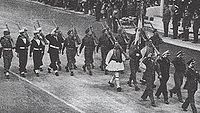
Turkey
Turkey , known officially as the Republic of Turkey , is a Eurasian country located in Western Asia and in East Thrace in Southeastern Europe...
, to the British-controlled Middle East
Middle East
The Middle East is a region that encompasses Western Asia and Northern Africa. It is often used as a synonym for Near East, in opposition to Far East...
. There they were placed under British command and re-equipped with British arms, complemented by volunteers from the local Greek communities, forming the "Royal Hellenic Army in the Middle East" (Βασιλικός Ελληνικός Στρατός Μέσης Ανατολής, ΒΕΣΜΑ).
Already on 23 June 1941, the 1st Greek Brigade began being formed in Palestine under Col. Ev. Antoniou. It comprised ca. 5,000 men in three infantry battalions, an artillery regiment (of battalion-size), and support units. An independent armoured car regiment (of battalion size) was also formed, but later incorporated in the Brigade's artillery regiment. The Brigade remained in training camps in Palestine until May 1942, where its command was taken over by Col. Pafsanias Katsotas. It was then transferred to Syria, before being deployed to Egypt in August. There it was placed under British 50th Division
British 50th (Northumbrian) Infantry Division
The 50th Infantry Division was a 1st Line Territorial Army division during the Second World War. The two Ts in its insignia represent the two boundaries to its recruitment area, the rivers Tyne and Tees...
in the Nile Delta
Nile Delta
The Nile Delta is the delta formed in Northern Egypt where the Nile River spreads out and drains into the Mediterranean Sea. It is one of the world's largest river deltas—from Alexandria in the west to Port Said in the east, it covers some 240 km of Mediterranean coastline—and is a rich...
, and joined it in the Second Battle of El Alamein
Second Battle of El Alamein
The Second Battle of El Alamein marked a major turning point in the Western Desert Campaign of the Second World War. The battle took place over 20 days from 23 October – 11 November 1942. The First Battle of El Alamein had stalled the Axis advance. Thereafter, Lieutenant-General Bernard Montgomery...
, where it suffered 89 dead and 228 wounded. A 2nd Brigade also began being formed in Egypt since 27 July 1942 along similar lines, but did not see action.
Both Brigades remained on guard duty in Egypt and Libya, where they became involved in the widespread pro-EAM
Ethniko Apeleftherotiko Metopo
The National Liberation Front was the main movement of the Greek Resistance during the Axis occupation of Greece during World War II. Its main driving force was the Communist Party of Greece , but its membership throughout the Occupation period included several other leftist and republican groups...
mutiny in April 1944. Subsequently, both units were disbanded by the British, and their personnel interned in camps or used in non-combat duties. 3,500 politically reliable officers and men were formed into the III Greek Mountain Brigade under Col. Thrasyvoulos Tsakalotos
Thrasyvoulos Tsakalotos
Thrasyvoulos Tsakalotos , was a Hellenic Army officer who served in World War I, the Greco-Turkish War of 1919–1922 and World War II, rising to become Chief of the Hellenic Army General Staff....
, on 4 June 1944. This unit was embarked for Italy
Italian Campaign (World War II)
The Italian Campaign of World War II was the name of Allied operations in and around Italy, from 1943 to the end of the war in Europe. Joint Allied Forces Headquarters AFHQ was operationally responsible for all Allied land forces in the Mediterranean theatre, and it planned and commanded the...
in August and fought with distinction, particularly at the Battle of Rimini
Battle of Rimini (1944)
The Battle of Rimini took place in between 13 and 21 September 1944 during Operation Olive, the main Allied offensive on the Gothic Line in August and September 1944, part of the Italian Campaign in the Second World War. Rimini, a town on the Adriatic coast of Italy, anchored the Rimini Line, a...
, where it earned the honorific Rimini Brigade. This loyal and battle-hardened unit would later be instrumental in the struggle between the British-backed government and the EAM
Ethniko Apeleftherotiko Metopo
The National Liberation Front was the main movement of the Greek Resistance during the Axis occupation of Greece during World War II. Its main driving force was the Communist Party of Greece , but its membership throughout the Occupation period included several other leftist and republican groups...
-ELAS forces.
In September 1942, an elite special forces
Special forces
Special forces, or special operations forces are terms used to describe elite military tactical teams trained to perform high-risk dangerous missions that conventional units cannot perform...
unit, the Sacred Band
Sacred Band (World War II)
The Sacred band was a Greek special forces unit formed in 1942 in the Middle East, composed entirely of Greek officers and officer cadets under the command of Col. Christodoulos Tsigantes. It fought alongside the SAS in the Libyan desert and the Aegean, as well as with General Leclerc's Free...
(Ιερός Λόχος), was formed, made up solely of officers and volunteers. Under its charismatic leader, Col. Christodoulos Tsigantes, it was attached to the 1st SAS
Special Air Service
Special Air Service or SAS is a corps of the British Army constituted on 31 May 1950. They are part of the United Kingdom Special Forces and have served as a model for the special forces of many other countries all over the world...
Regiment, and participated in raids in Libya. In February 1943, the unit was placed under the orders of General Philippe Leclerc
Philippe Leclerc de Hauteclocque
Philippe François Marie, comte de Hauteclocque, then Leclerc de Hauteclocque, by a 1945 decree that incorporated his French Resistance alias Jacques-Philippe Leclerc to his name, , was a French general during World War II...
, and participated in the Tunisia Campaign
Tunisia Campaign
The Tunisia Campaign was a series of battles that took place in Tunisia during the North African Campaign of the Second World War, between Axis and Allied forces. The Allies consisted of British Imperial Forces, including Polish and Greek contingents, with American and French corps...
. From May to October 1943, the Sacred Band was re-trained in airborne and amphibious operations, and for the remainder of the war it was employed in operations against the German garrisons of the Aegean islands. The unit was disbanded in Athens, on 7 August 1945.
Navy
The Hellenic Royal Navy suffered enormous casualties during the German invasion, losing over 20 ships, mostly to German air attacks, within a few days in April 1941. Its chief, Vice Admiral Alexandros SakellariouAlexandros Sakellariou
Alexandros Sakellariou was a Greek admiral and politician.Sakellariou entered the Hellenic Naval Academy in 1906, and served in the Royal Hellenic Navy in the Balkan Wars and until 1918, when he was discharged due to his royalist convictions during the National Schism. As with many other royalist...
, managed to save some of its ships, including the cruiser Averof
Greek cruiser Georgios Averof
Georgios Averof is a Greek warship which served as the flagship of the Royal Hellenic Navy during most of the first half of the 20th Century...
, six destroyers, five submarines and several support ships, by evacuating them to Alexandria
Alexandria
Alexandria is the second-largest city of Egypt, with a population of 4.1 million, extending about along the coast of the Mediterranean Sea in the north central part of the country; it is also the largest city lying directly on the Mediterranean coast. It is Egypt's largest seaport, serving...
. The fleet was subsequently expanded by several destroyers, submarines, mine-sweepers and other vessels handed over by the British Royal Navy
Royal Navy
The Royal Navy is the naval warfare service branch of the British Armed Forces. Founded in the 16th century, it is the oldest service branch and is known as the Senior Service...
, until it became, with 44 ships and over 8,500 men, the second-largest Allied Navy in the Mediterranean
Mediterranean Sea
The Mediterranean Sea is a sea connected to the Atlantic Ocean surrounded by the Mediterranean region and almost completely enclosed by land: on the north by Anatolia and Europe, on the south by North Africa, and on the east by the Levant...
after the RN, accounting for 80% of all non-RN operations.
Greek ships served in convoy escort duties in the Indian Ocean
Indian Ocean
The Indian Ocean is the third largest of the world's oceanic divisions, covering approximately 20% of the water on the Earth's surface. It is bounded on the north by the Indian Subcontinent and Arabian Peninsula ; on the west by eastern Africa; on the east by Indochina, the Sunda Islands, and...
, the Mediterranean, the Atlantic and Arctic Oceans. RHN ships also participated in the landing operations in Sicily
Allied invasion of Sicily
The Allied invasion of Sicily, codenamed Operation Husky, was a major World War II campaign, in which the Allies took Sicily from the Axis . It was a large scale amphibious and airborne operation, followed by six weeks of land combat. It launched the Italian Campaign.Husky began on the night of...
, Anzio
Operation Shingle
Operation Shingle , during the Italian Campaign of World War II, was an Allied amphibious landing against Axis forces in the area of Anzio and Nettuno, Italy. The operation was commanded by Major General John P. Lucas and was intended to outflank German forces of the Winter Line and enable an...
and Normandy
Operation Overlord
Operation Overlord was the code name for the Battle of Normandy, the operation that launched the invasion of German-occupied western Europe during World War II by Allied forces. The operation commenced on 6 June 1944 with the Normandy landings...
, as well as at the ill-fated Dodecanese Campaign
Dodecanese Campaign
The Dodecanese Campaign of World War II was an attempt by Allied forces, mostly British, to capture the Italian-held Dodecanese islands in the Aegean Sea following the surrender of Italy in September 1943, and use them as bases against the German-controlled Balkans...
. A significant moment in the RHN's history was the acceptance of the Italian Fleet
Regia Marina
The Regia Marina dates from the proclamation of the Kingdom of Italy in 1861 after Italian unification...
's surrender in September 1943, alongside the British Royal Navy. Two of the most notable Greek warships of the war were the destroyers Adrias and Vasilissa Olga
Greek destroyer Vasilissa Olga (D 15)
Vasilissa Olga was a Greek destroyer of the Vasilefs Georgios class, which served with the Royal Hellenic Navy during the Second World War, becoming its most distinguished and successful ship until her loss in 1943...
. The large Greek merchant navy, likewise, contributed enormously to the Allied war effort from the first day of the war, losing over 2,500 men and 60% of its ships in the process.
When the pro-EAM April 1944 mutiny broke out, a large part of the Navy joined it. These ships were stormed by Greek officers loyal to the government-in-exile and recaptured. Eleven seamen were killed, others wounded, and many were subsequently interned. Thus, when the Navy returned to liberated Greece in October 1944, it was firmly behind the government of George Papandreou
George Papandreou (senior)
Georgios Papandreou was a Greek politician, the founder of the Papandreou political dynasty. He served three terms as Prime Minister of Greece...
.
Air Force
The few Air Force personnel that managed to escape eventually constituted the 13th Light Bomber13th Light Bomber Squadron
The 13th Light Bomber Squadron , was one of the three World War II aircraft squadrons in service with the Royal Hellenic Air Force, exiled in the Middle East, that fought under the auspices of the British Royal Air Force...
and the 335th and 336th Fighter squadrons, operating under the Desert Air Force
Desert Air Force
The Desert Air Force , also known chronologically as Air Headquarters Western Desert, Air Headquarters Libya, AHQ Western Desert, the Western Desert Air Force, Desert Air Force, and the First Tactical Air Force , was an Allied tactical air force initially created from No...
in North Africa and Italy, before being repatriated in late 1944.
13th Squadron was formed in June 1941 in Egypt as a naval cooperation unit, using the 5 surviving Avro Anson
Avro Anson
The Avro Anson is a British twin-engine, multi-role aircraft that served with the Royal Air Force, Fleet Air Arm and numerous other air forces prior to, during, and after the Second World War. Named for British Admiral George Anson, it was originally designed for maritime reconnaissance, but was...
s of the former RHAF 13th Naval Cooperation Squadron. The Squadron was later reequipped with Blenheim
Bristol Blenheim
The Bristol Blenheim was a British light bomber aircraft designed and built by the Bristol Aeroplane Company that was used extensively in the early days of the Second World War. It was adapted as an interim long-range and night fighter, pending the availability of the Beaufighter...
s and, later, Baltimore
Martin Baltimore
The Martin 187 Baltimore was a two-engined light attack bomber built by the Glenn L. Martin Company in the United States, originally ordered by the French in May 1940 as a follow-up to the earlier Martin Maryland, then in service in France. With the fall of France, the production series was...
s. 335 Squadron was formed on 10 October 1941, while 336 Squadron on 25 February 1943. Both were initially equipped with Hurricane
Hawker Hurricane
The Hawker Hurricane is a British single-seat fighter aircraft that was designed and predominantly built by Hawker Aircraft Ltd for the Royal Air Force...
s, mostly of the Mk. IIc type, until they were re-equipped with Spitfire
Supermarine Spitfire
The Supermarine Spitfire is a British single-seat fighter aircraft that was used by the Royal Air Force and many other Allied countries throughout the Second World War. The Spitfire continued to be used as a front line fighter and in secondary roles into the 1950s...
Mk Vb and Vc in January 1944.
Liberation & civil war
Soon after the war Greece descended into chaos and civil war.In popular culture
The Axis occupation of Greece, specifically the Greek islands, figures large in English speaking books and films, with real special forces raids such as Ill Met by MoonlightIll Met by Moonlight
Ill Met by Moonlight , also known as Night Ambush, is a film by the British writer-director-producer team of Michael Powell and Emeric Pressburger, the last film they made together through their Archers production company...
, The Cretan Runner
The Cretan Runner
The Cretan Runner: His Story of the German Occupation is a book written by George Psychoundakis...
, fictional ones like The Guns of Navarone
The Guns of Navarone (film)
The Guns of Navarone is a 1961 British-American Action/Adventure war film based on the 1957 novel of the same name about the Dodecanese Campaign of World War II by Scottish thriller writer Alistair MacLean. It stars Gregory Peck, David Niven and Anthony Quinn, along with Anthony Quayle and Stanley...
, Escape to Athena
Escape to Athena
Escape to Athena is a British adventure war film released in 1979, directed by George Pan Cosmatos and produced by Lew Grade's ITC Entertainment. The international cast included many well-known actors of the 1970s, including Roger Moore, Telly Savalas and Elliott Gould.The film is set during the...
or They Who Dare and Captain Corelli's Mandolin
Captain Corelli's Mandolin
Captain Corelli's Mandolin, released simultaneously as Corelli's Mandolin. in the United States, is a 1994 novel written by Louis de Bernières which takes place on the island of Cephallonia during the Italian and German occupation of World War II. The main characters are Antonio Corelli, an...
, a fictional occupation narrative.
Sources
- Center of Military History (1953 – Reissue edition 1984-1986). German Antiguerrilla Operations in The Balkans (1941-1944) Washington DC: United States ArmyUnited States ArmyThe United States Army is the main branch of the United States Armed Forces responsible for land-based military operations. It is the largest and oldest established branch of the U.S. military, and is one of seven U.S. uniformed services...
.
External links
- Memorandum to the Note to the Greek Government, April 6, 1941
- Note of the Reich Government to the Greek Government, April 6, 1941
- "Heroes fight like Greeks" Documentary film about Greece in World War II.

